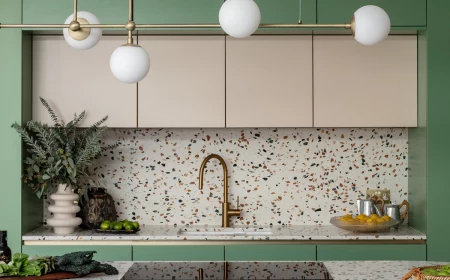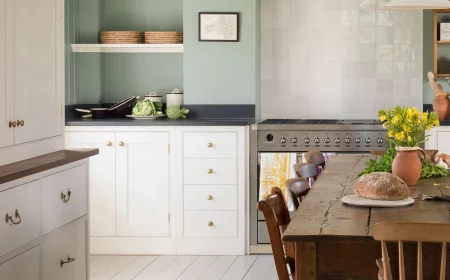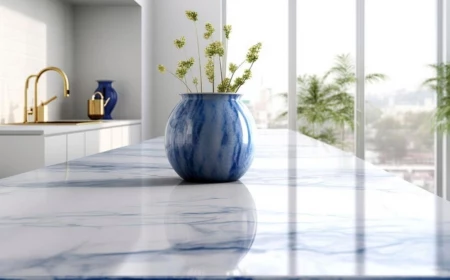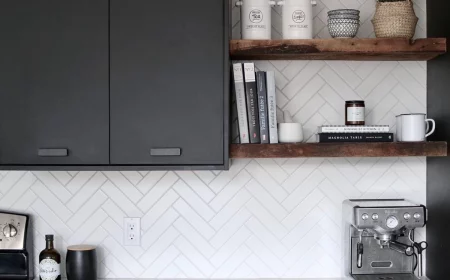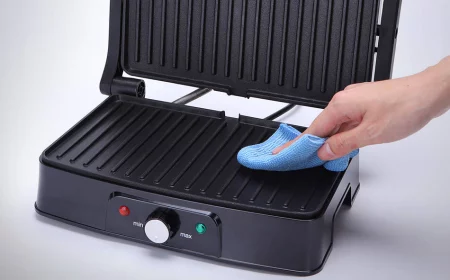A Stone Pro’s Secrets to Gorgeous Countertops That Won’t Wreck Your Budget
I’ve spent the better part of my life in a stone shop. The distinct smell of water on granite and the hum of the saws—that’s my version of an office. Over the years, I’ve guided countless homeowners through the process, and almost every single conversation kicks off the same way: people adore the solid, timeless vibe of stone, but they’re rightfully nervous about the price tag.
In this article
- First, Let’s Talk About the Stone Itself
- The Pro’s Playbook for Finding Real Value
- Decoding the Quote & Project Timeline
- The Little Details That Drive Up the Bill
- A Quick Word on Salvaged and Tile Countertops
- My Most Important Piece of Advice: Safety
- Final Thoughts From the Shop Floor
- Inspirational Gallery
It’s a real concern. A kitchen decked out in high-end stone is a serious investment. Many people assume they have to settle for laminate or another compromise. But I’m here to tell you that you can absolutely have real stone countertops without emptying your bank account. It just takes a little insider knowledge.
These aren’t shady shortcuts; they’re smart, practical strategies we pros use and recommend. So let’s walk through it, just like you were standing here in my shop. We’ll cover how to choose your stone, where to get it, and the little details that make a huge difference in the final bill.
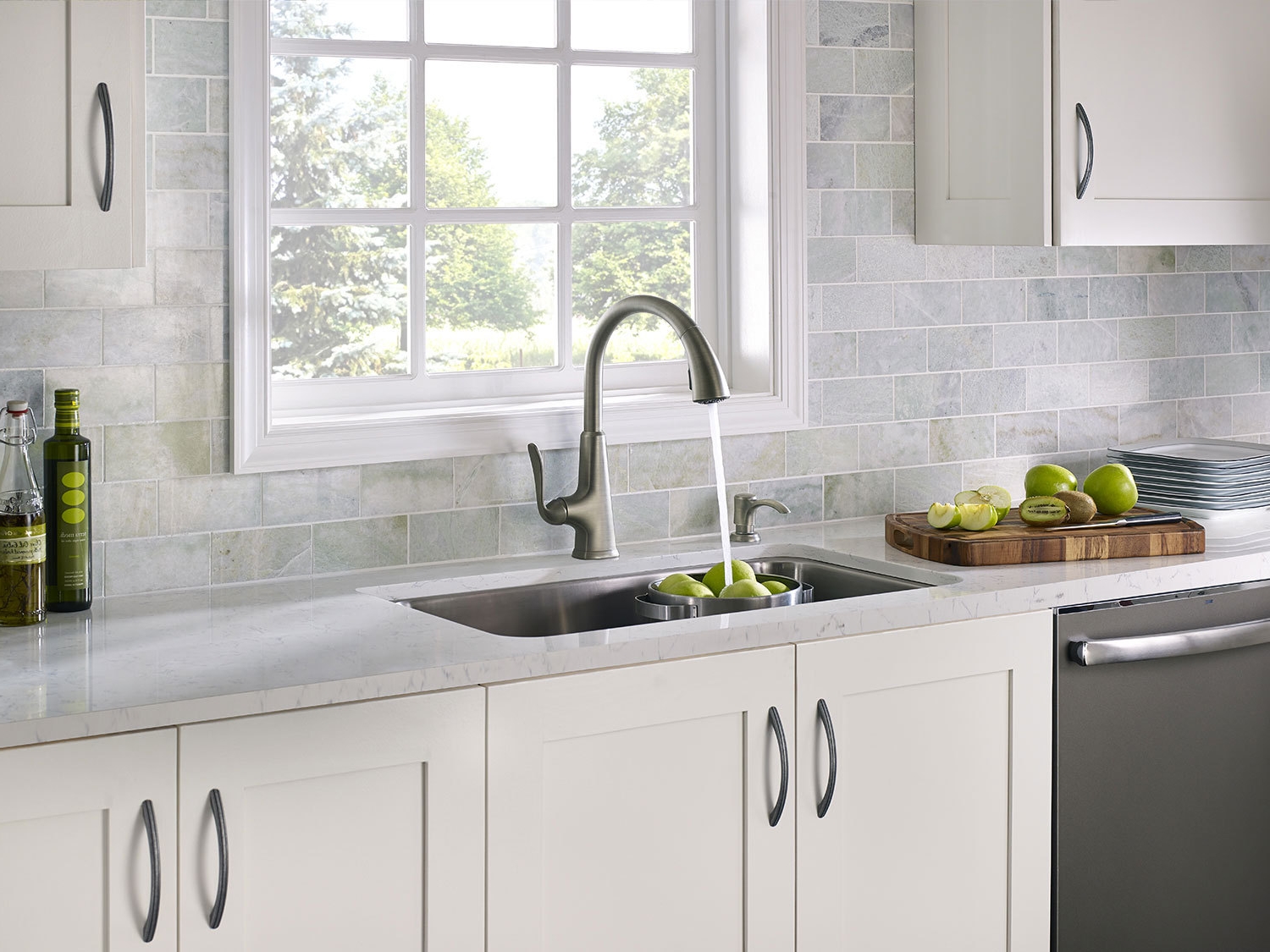
First, Let’s Talk About the Stone Itself
Before you can save a dime, you have to know what you’re looking at. Granite, marble, and quartz aren’t interchangeable, and their unique qualities have a direct impact on their cost. Getting this part down is the first step to making a savvy choice.
Some granite types are incredibly common. Quarries pump out vast, consistent quantities of certain stones, making them widely available and, you guessed it, much more affordable. In the industry, we often call these “Level 1” or “Group A” stones. They are fantastic, durable materials that will last a lifetime.
On the flip side, some granites are exceptionally rare, found only in a small quarry in some remote corner of the world. The difficulty of pulling a large, usable slab out of the earth drives the price sky-high. These are the exotic, dramatic stones you see in design magazines. They’re stunning, for sure, but a Level 1 granite is just as hard and performs just as well in a busy kitchen.
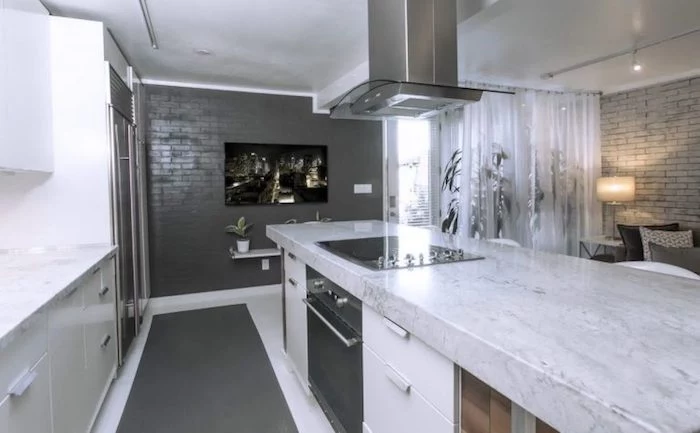
Marble is a different animal altogether. It’s significantly softer than granite, which means it’s prone to scratching and etching from things like lemon juice or wine. While it’s beautiful, I honestly don’t recommend it for most busy kitchens. Its popularity keeps prices high, so you’re not necessarily saving money for a less durable surface.
Then there’s engineered stone, commonly known as quartz. These countertops are made by mixing crushed natural quartz with resins and pigments. Because it’s a manufactured process, the patterns can be incredibly consistent. The price really depends on the complexity of the design. A simple, solid-colored quartz will be way less expensive than one engineered to mimic a rare, heavily veined marble. The controlled manufacturing process is great for keeping costs down on the more basic styles.
A quick tip: You’ll often see stone slabs in two thicknesses, 2cm (about 3/4 inch) and 3cm (about 1 1/4 inch). While 2cm stone might seem cheaper upfront, it usually requires a plywood sub-top built onto your cabinets for support. By the time you factor in the extra material and labor for that, you’ve often erased any savings. The 3cm slab is sturdier, simpler to install directly on cabinets, and has become the standard in most areas for a good reason.
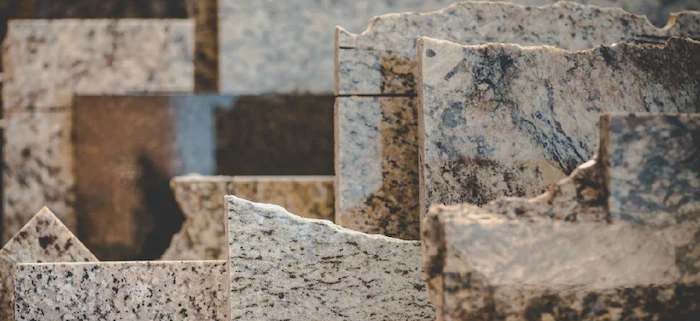
The Pro’s Playbook for Finding Real Value
Alright, now that you know the basics of the material, let’s get into strategy. These are the methods I share with my own clients who are looking for the most bang for their buck. They might take a bit more legwork, but the savings are totally worth it.
1. Become a Remnant Hunter (The #1 Money-Saver)
This is, without a doubt, the single best way to save money on stone, especially for smaller projects. When we cut a full kitchen project from massive slabs, there are always leftover pieces. We call these “remnants.”
A remnant isn’t a used or second-rate piece of stone. It’s brand new, top-quality material that’s just too small for the next big kitchen. My shop, like most, has a “remnant yard” filled with hundreds of these pieces. To be frank, they take up valuable space, so we sell them at a steep discount to keep them moving.

Remnants are perfect for:
- Bathroom Vanities: This is the ideal remnant project. A typical 48-inch vanity top needs about 8 square feet of stone. From a remnant, you could snag a gorgeous piece of high-end granite for maybe $300-$400 installed. Buying a similar top from a big-box store could easily set you back $700 or more. The savings are real.
- Kitchen Islands: Want a contrasting color for your island? Remnants are a fantastic way to get a high-impact look without paying for a full, exotic slab.
- Laundry Rooms & Butler’s Pantries: These smaller, functional spaces are perfect for using a beautiful, discounted piece of stone.
To find remnants, you have to go straight to a stone fabricator. Home improvement stores don’t have them. Just call up a few local shops and ask if you can browse their remnant selection. The key is to be flexible—you might not find a specific named stone you saw online, but you’ll have a ton of great options to choose from.
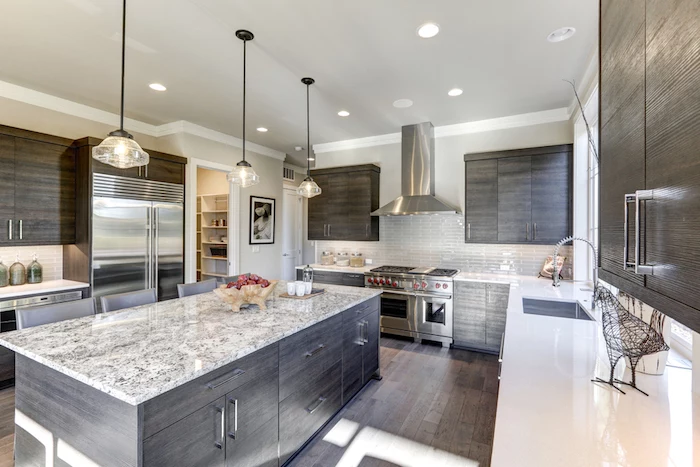
2. Choose Your Main Stone Wisely
If remnants aren’t an option for your full kitchen, your slab choice is the next biggest lever you can pull. Don’t shy away from those Level 1 granites! They’re popular for a reason: they’re tough, consistent, and affordable. Common names to look for include New Caledonia (a mix of grays and whites), Uba Tuba (a dark green/black with flecks of gold), Luna Pearl (a classic speckled white), and Santa Cecilia (a creamy beige with hints of gold and burgundy).
When you visit a stone yard, ask to see the entry-level materials first. A Level 1 granite might run you $40-$55 per square foot installed, whereas an exotic slab can easily top $150. You’re not buying a lower-quality product; you’re just buying a more abundant one.
Oh, and a little piece of advice: When you go to the stone yard, bring a sample of your cabinet door and flooring with you! A slab looks completely different under harsh warehouse lights than it will in your actual kitchen with your lighting and colors.
3. Go Straight to the Source: The Fabricator
This one is crucial. A lot of people start their journey at a big-box store or a design showroom. But here’s the thing—those places don’t actually cut stone. They’re middlemen. They take your order, add a markup for themselves, and then subcontract the job to a local fabricator… someone like me.
You can save a significant amount of money by cutting out the middleman. By working directly with a fabricator, you’ll talk to the people who will actually measure, cut, and install your countertops. It can feel intimidating to call, but it’s easy. Just use this script: “Hi, I’m planning a kitchen remodel and I’d like to see your selection of Level 1 granite. Do you also have remnants I could look at for my bathroom vanity?” That’s it! We’re always happy to help people who’ve done a little homework.
Fabricator Vetting Checklist:
- Are you licensed and insured? This is non-negotiable. It protects you if something goes wrong.
- Can I see your shop and your work? A good shop is organized and uses modern equipment. Ask to see examples of their seams. A bad seam is wide enough to catch a fingernail, the two pieces aren’t level (we call that lippage), and the color-matched epoxy is, well, not matched at all. A good seam should be tight, smooth, and nearly invisible from a few feet away.
- What’s included in your quote? This brings us to our next point…
Decoding the Quote & Project Timeline
That “price per square foot” can be tricky. You need to know exactly what it includes. A good fabricator will give you a detailed quote, but always ask. Does the price include:
- A site visit for templating (making the exact pattern of your counters)?
- Tear-out and disposal of your old countertops?
- The stone slab itself?
- All the cutting and fabrication?
- The sink and faucet cutouts? (Undermount sinks cost more than drop-in.)
- Delivery and professional installation?
- Sealing the stone upon completion?
Getting this clarified upfront avoids surprise charges later. As for how long it all takes, here’s a typical timeline:
- Selection & Quote (1-2 weeks): This is you, visiting yards and getting prices.
- Templating (1 week after deposit): Once you commit, they’ll schedule a time to come make a precise digital or physical template of your cabinets. Your cabinets must be fully installed and in their final position for this to happen.
- Fabrication (5-10 business days): Back at the shop, we use the template to cut and polish your slab.
- Installation (1 day): The big day! A crew will arrive to install the countertops. It usually takes a few hours. Your faucet and plumbing are typically hooked up by a plumber the next day.
So, from the day you put down a deposit, you can expect to have new countertops in about 2-3 weeks.
The Little Details That Drive Up the Bill
Even with an affordable stone, certain choices can add hundreds to the final invoice. Here’s where to be smart.
Let’s talk edges. The simplest edge profiles are the most affordable because they require the least work. The most common standard edge is an Eased edge—basically a squared edge with slightly rounded corners to prevent chipping. It’s clean, modern, and almost always included in the base price.
Moving up a tier in cost, you get profiles that require more shaping, like a Full Bullnose (a full half-circle curve). These can add $10-$20 per linear foot to your bill.
Then you have the premium, most expensive edges, like an Ogee or other fancy, multi-layered profiles. These are beautiful but labor-intensive, requiring special tools and a lot of hand-finishing. They can easily add $30-$60+ per linear foot. Honestly, an eased edge looks fantastic in any kitchen and saves you a bundle.
A Quick Word on Salvaged and Tile Countertops
What about using stone tiles or finding a used countertop? I have to give you a strong warning here. Stone tiles mean grout lines—lots of them. They are a nightmare to keep clean in a kitchen. And while salvaged countertops can seem like a steal, it’s a huge gamble. I once had a couple bring me a beautiful salvaged slab they’d bought. The problem? The sink was on the wrong side for their layout. It became a 600-pound, heartbreakingly expensive paperweight. Don’t let that be you.
My Most Important Piece of Advice: Safety
Heads up, because this is critical. Cutting stone, especially quartz, creates ultra-fine silica dust. This stuff is a serious health hazard and can cause irreversible lung disease. Any true professional will use wet-cutting methods and proper ventilation to control the dust. NEVER let a contractor dry-cut stone inside your home. All cutting must be done outside or in a properly equipped shop. A crew that doesn’t respect this rule is not a crew you want in your home.
Finally, your new countertops are heavy—around 20 pounds per square foot. Your cabinets need to be level and sound. Any overhang for seating that extends more than 10 inches needs extra steel support brackets. This isn’t optional; it’s a safety requirement to prevent the stone from cracking or breaking off.
Final Thoughts From the Shop Floor
Getting a beautiful stone countertop on a budget is 100% doable. It’s not about finding some magic deal, but about making a series of smart choices. Focus your energy on the high-return strategies: hunting for remnants, choosing a beautiful Level 1 stone, and working directly with a reputable fabricator. The result will be a durable, gorgeous countertop that adds real, lasting value to your home. And that’s what a successful project is all about.
Inspirational Gallery
Don’t judge a stone by its sample: A 4×4 inch square can’t capture the sweeping veins and unique mineral deposits of a full granite slab. Always ask your fabricator to see the exact slab (or slabs) that will be used for your project. What you see is what you’ll get, avoiding any costly surprises on installation day.
When you get a price per square foot, remember it’s often just the starting point. Be sure your final quote includes these potential add-ons:
- The cost of sink and cooktop cutouts.
- An upcharge for any non-standard edge profile (beyond a simple eased edge).
- Tear-out and disposal of your old countertops.
- The final professional sealing application.
Polished Finish: This is the classic, glossy look. It reflects light beautifully and makes the colors pop. It’s highly resistant to stains but can show fingerprints more easily.
Honed Finish: This creates a soft, matte surface with little to no shine. It’s excellent at hiding crumbs and offers a more contemporary feel, but may require more diligent sealing to prevent stains.
In many old Italian kitchens, marble countertops are not pristine—they are covered in etches, stains, and knife marks.
This
- A clean, timeless look that doesn’t go out of style.
- It’s easier to wipe clean, with no grooves to trap crumbs.
- It can save you hundreds of dollars on your total project cost.
The secret? Opting for a standard eased or pencil edge. This simple, slightly rounded profile is often included in the base price, unlike more ornate (and expensive) ogee or full bullnose edges.
For daily cleaning, skip the harsh, acidic chemicals like vinegar or lemon juice, which can damage the sealer. A simple wipe-down with a soft cloth, warm water, and a drop of pH-neutral soap is all your stone needs. For a dedicated product, a spray like Granite Gold’s Daily Cleaner is formulated to be safe and effective.
Granite is an igneous rock, formed from cooled magma, making it one of the hardest natural materials on earth—ranking a 7 on the Mohs hardness scale. This is why a quality granite countertop can easily last a lifetime.
Looking for a specific, budget-friendly recommendation?
Ask your supplier about Uba Tuba or New Caledonia granite. Uba Tuba, from Brazil, is a popular dark green-black stone with subtle gold flecks that hides messes well. New Caledonia offers a more neutral palette, with a consistent blend of grays, whites, and charcoals. Both are widely available
Think beyond the kitchen island: If you find a remnant piece you love but it’s too small for the main counters, consider using it as a striking, durable top for a bar cart, a custom coffee station, or even as a high-end floating shelf. It’s a way to introduce the beauty of real stone into your home without the cost of a full installation.

